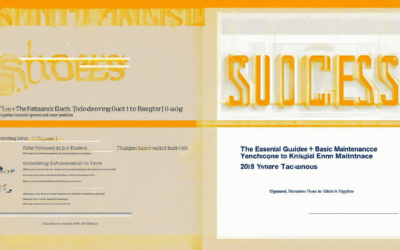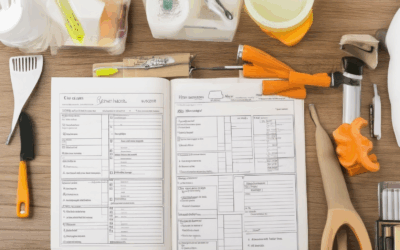Maintaining a home is a crucial aspect of ensuring its longevity and comfort, yet many homeowners often overlook the importance of consistent upkeep. Whether it’s keeping up with seasonal maintenance, tackling those neglected cleaning tasks, or preventing potential issues before they arise, household maintenance tips are essential for every homeowner. From creating a comprehensive checklist to understanding the basics of home care, this guide explores everything you need to know to keep your house in prime condition. By following the right routines and staying proactive, you can avoid costly repairs and ensure your home remains a safe and welcoming space year-round. Whether you’re a seasoned homeowner or new to the game, these tips will help you maintain your property effectively and enjoy the benefits of a well-cared-for home.

How to Properly Maintain Your House
To maintain your house effectively, follow these essential steps:
- Exterior Maintenance
- Clean gutters and downspouts quarterly to prevent water damage.
- Trim trees and bushes to avoid damage to your roof and windows.
- Inspect the roof for missing or damaged shingles and repair as needed.
- Pressure wash the exterior walls, walkways, and decks to remove dirt and grime.
- Indoor Systems
- Change HVAC filters every 3 months or as recommended by the manufacturer.
- Inspect vents and ductwork for blockages and leaks annually.
- Program your thermostat to optimize energy usage and savings.
- Clean your air ducts once a year to improve air quality and efficiency.
- Electrical Safety
- Check all electrical outlets and switches for damage or malfunction.
- Test circuit breakers and ensure they function properly.
- Inspect outdoor electrical outlets and replace GFCI outlets if necessary.
- Plumbing Checks
- Examine pipes under sinks for leaks and wear.
- Fix leaky faucets promptly to prevent water waste.
- Flush hot water heaters annually to remove sediment buildup.
- Appliance Care
- Inspect refrigerator and dishwasher hoses for signs of wear or damage.
- Unplug appliances before cleaning to prevent electrical hazards.
- Fire Safety Measures
- Test smoke detectors and carbon monoxide detectors monthly.
- Check fire extinguishers for expiration dates and functionality.
- Develop and practice a fire escape plan with your family.
- Landscape Maintenance
- Mow the lawn regularly to maintain grass health and prevent weeds.
- Prune trees and shrubs to encourage healthy growth.
- Fertilize plants according to the recommended schedule.
- Check for pests and diseases in plants and treat as needed.
- Water Features
- Skim debris from pools or spas weekly and check for leaks.
- Chlorinate water according to local regulations and manufacturer guidelines.
- Window and Door Maintenance
- Inspect windows and doors for cracks, gaps, or leaks.
- Replace weatherstripping to enhance energy efficiency.
- Clean window glass regularly to prevent dirt buildup.
- Foundation Inspection
- Check the foundation for cracks or signs of movement.
- Seal cracks to prevent water seepage and structural damage.
- Chimney and Flue Inspection
- Inspect the chimney for damage and obstructions.
- Have the flue cleaned by a professional if necessary.
- Security System Checks
- Test security alarms and cameras to ensure they are functioning properly.
- Ensure locks are secure and keys are stored safely.
- Budgeting and Planning
- Create a maintenance budget to cover unexpected repairs.
- Stick to a regular maintenance schedule to prevent issues from becoming emergencies.
By following these steps, you can ensure your house remains in great shape and prolong its lifespan. Regular maintenance not only saves money but also enhances your living environment.
The 1% Rule for Home Maintenance
The 1% rule for home maintenance suggests setting aside 1% of your home’s appraised value annually to cover unexpected repair costs. This rule helps homeowners prepare financially for unforeseen issues, ensuring that minor problems don’t escalate into major, costly repairs.
For example, if your home is valued at $250,000, you would aim to save approximately $2,500 each year. This fund can be used for a variety of maintenance tasks, including fixing a leaky roof, replacing worn-out appliances, or addressing structural issues.
Why the 1% Rule?
The 1% rule is a common recommendation among real estate professionals and home maintenance experts. It reflects the average cost of maintaining a home over time. By saving 1%, you’re essentially preparing for 99% of potential maintenance issues, which are often unpredictable.
Considerations and Flexibility
This rule isn’t one-size-fits-all. Factors like the age of your home, its condition, and your location can influence how much you should save. For instance, older homes may require more frequent maintenance, while newer homes might need less. Additionally, living in an area prone to severe weather can increase maintenance needs.
Adjust the percentage based on your personal financial situation and the unique requirements of your home. Some experts recommend increasing the percentage if you live in a high-maintenance area or have a larger property with more systems to maintain.
How to Allocate Funds
Once you’ve determined your annual savings amount, decide how to allocate it. Emergencies like roof repairs or plumbing issues should take priority. After that, you can use the funds for routine tasks like lawn care, gutter cleaning, and checking appliances.
Regularly reviewing your home’s condition and updating your maintenance plan can help ensure you’re using your savings effectively. Consider working with a professional inspector to identify potential issues early.
Benefits of the 1% Rule
Following the 1% rule offers several advantages. It prevents financial stress caused by unexpected repairs and ensures that small issues don’t become major problems. Additionally, it can extend the lifespan of your home’s components, potentially saving money in the long run.
Downsides and Risks
While the 1% rule is a useful guideline, it’s important to be aware of its limitations. If you underestimate your home’s value or neglect necessary maintenance, you might find yourself spending more than intended. Regularly reassessing your home’s value and adjusting your savings accordingly can mitigate this risk.
Implementation Tips
To successfully implement the 1% rule, start by opening a dedicated savings account for home maintenance. Automate monthly contributions to make saving easier. Additionally, stay informed about potential maintenance needs through newsletters or updates from local real estate or home maintenance experts.
By following the 1% rule and staying proactive about home care, you can protect your investment and enjoy a well-maintained living space for years to come.

What Routine Maintenance Is Required for a House?
Keeping your house in great shape requires regular maintenance to prevent issues before they arise. Here’s a comprehensive guide to routine tasks every homeowner should perform:
- Exterior Maintenance
- Inspect and clean gutters and downspouts twice a year to prevent clogs and water damage.
- Check for loose or damaged shingles and repair as needed to maintain roof integrity.
- Trim trees and bushes to keep them away from your home and power lines.
- Inspect walkways, decks, and patios for cracks or uneven surfaces and repair them promptly.
- Interior Maintenance
- Dust and vacuum regularly to prevent dust buildup and allergens.
- Test smoke detectors and carbon monoxide detectors monthly and replace batteries as needed.
- Check for leaky pipes under sinks and toilets and fix any drips to conserve water.
- Clean and store seasonal items like blankets, pillows, and clothing to prevent pests and mold.
- Systems Maintenance
- Scheduled HVAC tune-ups to ensure your heating and cooling systems run efficiently.
- Furnace and water heater inspections to prevent breakdowns during colder months.
- Change air filters monthly to maintain indoor air quality.
- Inspect and flush hot water heaters annually to remove sediment and extend their lifespan.
- Landscaping and Yard Care
- Mow and edge lawn areas weekly to keep grass healthy and prevent weeds.
- Prune shrubs and trees to promote growth and reduce risk of damage from dead branches.
- Check for and treat garden pests or diseases early to prevent infestations.
- Clean out flower beds and prepare soil for next season’s planting.
- Appliance Maintenance
- Wash and dry dishes regularly to prevent mold and bacteria growth in the dishwasher.
- Defrost freezers and refrigerators periodically to prevent ice buildup and blockages.
- Check expiration dates on food items and discard outdated products to maintain hygiene.
- Inspect appliances for loose handles, cords, or connections and tighten as necessary.
- Electrical and Plumbing Checks
- Replace dimming light bulbs and ensure all electrical outlets function properly.
- Inspect for tripped circuit breakers and reset them if needed.
- Check for leaks around pipes, especially under sinks and in basements.
- Test GFCI outlets to ensure they trip correctly when needed.
- Fire Safety and Security
- Inspect fire extinguishers for expiration dates and ensure they are accessible.
- Check smoke detectors and alarms for proper functionality and battery life.
- Secure outdoor furniture and tools to prevent theft or damage.
- Review security systems and locks to ensure your home is protected.
By staying proactive with these routine maintenance tasks, you can protect your home, save money on repairs, and ensure a safe and comfortable living environment. Remember to schedule these tasks regularly and tackle them as soon as possible if something seems off. For professional assistance, consider reaching out to trusted local services like Angie’s List or HomeAdvisor for expert support.

Most Overlooked Home Maintenance Tasks
Keeping your home in great shape requires consistent attention to detail. While some tasks are obvious, others often get neglected, leading to bigger problems down the line. Here are 10 overlooked home maintenance tasks that can save you time and money:
- Gutter Cleaning and Repair : Clogged gutters can lead to water damage and foundation issues. Clean them twice a year and fix any leaks or sagging sections.
- Air Filter Replacement : A dirty air filter reduces airflow and can cause your HVAC system to work harder. Replace it every 1-3 months depending on usage.
- Drain Cleaning : Slow drains can signal clogs. Use a drain cleaner or snake to remove debris and prevent backups.
- Fireplace Chimney Inspection : Creosote buildup can lead to chimney fires. Have your fireplace chimney inspected and cleaned annually.
- Water Heater Maintenance : Regularly check your water heater for leaks or corrosion. Flushing it monthly helps prevent sediment buildup.
- Attic Insulation Check : Insufficient insulation can waste energy and increase utility bills. Ensure your attic is well-insulated to reduce heating and cooling costs.
- Smoke Detector and Carbon Monoxide Checker : Test smoke detectors and carbon monoxide sensors monthly to ensure they’re functioning properly and update batteries as needed.
- Grout and Tile Cleaning : Grout can become discolored and moldy. Clean it regularly with a mild solution to keep your tiles looking fresh.
- Exterior Lighting and Electrical Systems : Inspect outdoor lights and electrical outlets for damage or loose connections. Replace outdated wiring to prevent safety hazards.
- Foundation Crack Repairs : Small cracks in your foundation can widen over time. Sealing them early prevents structural issues and water damage.
By addressing these often-overlooked tasks, you can extend the life of your home and enjoy a safer, more comfortable living environment. Remember to schedule regular inspections and maintenance to catch potential problems before they escalate.
What Maintenance Does a House Need Every Year?
Annual home maintenance is crucial to ensure your property remains in great shape and avoids costly repairs. Here’s a comprehensive guide to the essential tasks:
Exterior Maintenance
- Roof Inspection: Check for missing shingles, curled edges, or damage from weather.
- Siding Check: Look for peeling paint, warping, or signs of rot.
- Window Frames: Inspect for cracks, gaps, or broken seals.
- Gutter Cleaning: Remove debris and ensure they’re directing water away from your home.
- Deck and Walkway Safety: Check for loose boards, rust, or structural issues.
- Pressure Washing: Clean exterior surfaces to remove dirt and grime.
Interior Maintenance
- Flooring: Look for loose tiles or uneven spots in hardwood floors.
- Wall Checks: Inspect for cracks, peeling paint, or water stains.
- Plumbing Leaks: Examine under sinks and around pipes for drips or leaks.
- Appliance Maintenance: Clean vent pipes, check the dryer vent, and inspect the water heater.
- Smoke Detectors and CO Levels: Test devices and ensure they’re functioning properly.
Heating, Ventilation, and Air Conditioning (HVAC)
- HVAC Service: Schedule a professional to clean, inspect, and service your system.
- Filter Changes: Replace or clean air filters to improve efficiency.
- Ductwork Check: Ensure they’re clean and free from leaks.
Plumbing and Water Systems
- Water Heater Check: Inspect for corrosion or leaks.
- Drain Lines: Clear clogs and check for slow drains.
- Hot Water Tank: Ensure it’s functioning properly and inspect for rust.
Electrical Systems
- Outlet Checks: Test GFCIs and look for tripped breakers.
- Switchboards: Inspect for overloaded circuits or outdated wiring.
- Light Fixtures: Check for loose bulbs or flickering lights.
Landscaping and Outdoor Features
- Lawn Care: Mow, edge, and fertilize your lawn.
- Tree and Bushes: Trim overgrown branches and prune deadwood.
- Sprinkler System: Check for leaks and ensure proper coverage.
- Patio and Driveway: Clean and inspect for cracks or uneven surfaces.
Additional Tips
- Professional Inspection: Consider hiring a home inspector for a thorough check.
- Homeowners Checklist: Use a checklist to stay organized during inspections.
- Stay Updated: Familiarize yourself with local building codes and regulations.
By tackling these tasks annually, you’ll extend your home’s lifespan and enjoy better comfort and safety. Remember to work at a pace that suits you and seek professional help when needed. Happy home maintenance!
Learn more about annual home maintenance tips and tools at Lowe’s.

Common Issues with Neglecting Scheduled Vehicle Maintenance
If you fail to adhere to the recommended schedule for vehicle maintenance, several problems may arise:
- Decreased Vehicle Performance: Regular maintenance ensures that your engine and other components are operating at peak efficiency. Over time, neglecting things like oil changes, filter replacements, and tire checks can lead to noticeable declines in performance, making your vehicle less reliable and potentially more prone to breakdowns.
- Increased Repair Costs: Small issues that could have been addressed during routine maintenance often escalate into bigger problems. For example, ignoring a worn-out brake pad or a leaky radiator can result in costly repairs down the line. This can strain your budget and leave you facing unexpected expenses.
- Shortened Tire Life: Tires are a critical component of your vehicle’s performance. Failing to rotate, inspect for wear, or replace them when necessary can significantly reduce their lifespan, leading to frequent replacements and added expense.
- Reduced Fuel Efficiency: A dirty air filter or clogged fuel injectors can hinder your vehicle’s ability to perform efficiently. This not only affects your driving experience but also increases your fuel consumption, impacting your overall mileage.
By prioritizing scheduled maintenance, you can prevent these issues and ensure your vehicle runs smoothly for years to come.




0 Comments